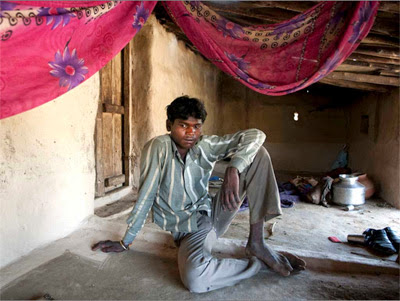Sahariyas of Bundelkhand Works Hard For Survival
Sahariyas of Bundelkhand Works Hard For Survival
In January this year, hoping to make some money, 16-year-old Babu Lal Sahariya left his home in Sakara village in southern Uttar Pradesh’s Lalitpur district and headed for the jungles of the adjoining state of Rajasthan. It was his eighth trip. His new job would require him to walk 30 km every day grazing cattle in return for two meals and Rs. 2000 a month. Babu Lal is one of hundred children belonging to the Sahariya tribe from the district who work as bonded labourers in the jungles of Madhya Pradesh (MP) and Rajasthan.
HT found that the Sahariyas, one of the 75 scheduled tribes in the country classified as Particularly Vulnerable Tribal Groups (earlier known as primitive tribal groups), are now so desperately poor that families have been pushing their children into modern day slavery in the hope of saving them from starvation. In exchange for paltry sums ranging between Rs. 2000 and Rs. 6000 a month, parents have been handing over their children to men who then transport them to different states. Of course, written contracts are unheard of.
Cut off from their families, the children work for an indefinite number of hours and often do not know when they will be permitted to return. But conditions at home are so grim that a number of children are eager to escape through work of this sort. “We Sahariyas are more than happy to make an honest living here in the village. But lately, due to price rise and various government policies, our lives have changed,” said Kundan Sahariya, 60, of Sakara village. A maze of narrow lanes, open drains, and shanties with thatched ceilings, Sakara is a nondescript place with no electricity supply. Electricity poles, however, hold out some hope. Villagers have to walk three km to access the public transport that can take them to the nearest primary health care centre 35 km away. The district supply officer of Lalitpur confirmed that around 70 of the 100 families in the village have the antyodaya ration cards that are issued to families with an income of less than Rs. 250 per capita per month.
According to the 2001 census, 88.8% of UP’s scheduled tribe (ST) population is rural. The Sahariyas were traditionally dependent on agriculture, the sale of forest produce and the rearing of livestock. “In the last two decades, their access to forests and common lands has become increasingly limited due to the demands of wildlife conservation and economic growth. As a consequence, the Sahariyas are increasingly depending on wage labour for subsistence,” said Asmita Kabra, associate professor, School of Human Ecology, Ambedkar University, Delhi (AUD) who has worked extensively with the community.
Distribution of land holding size among STs in the state is highly skewed. More than 50% of the farmers belong to marginal category with land holding size of 0.49 hectare, noted the state irrigation department. “This is compounded by bad quality of land. Investing on land in such regions is not wise as the return is zero,” said Vasudev, director, Bundelkhand Sewa Samiti, a grassroot organisation working with the Sahariyas.
Today, the villagers of Sakara depend on farming, selling tendu leaves and such government welfare schemes as MNREGA. Farming is often difficult as the area has little irrigation and MNREGA work has not been very helpful as payments are irregular, say villagers. To make ends meet and also to ensure that the children are at least fed, the tribe has been resorting to sending them away. While some villagers say kids have been sent out for the last decade or so, others who are apprehensive about media coverage insist the trend is only about two years old. “The authorities should criminalise non- payment of wages. Without it, landlords and other influencers will continue to exploit such communities,” says Chandan Kumar, National Co-Ordinator, Bonded Labour Eradication Programme, Action Aid.
Courtesy : hindustantimes.com
- Log in to post comments

